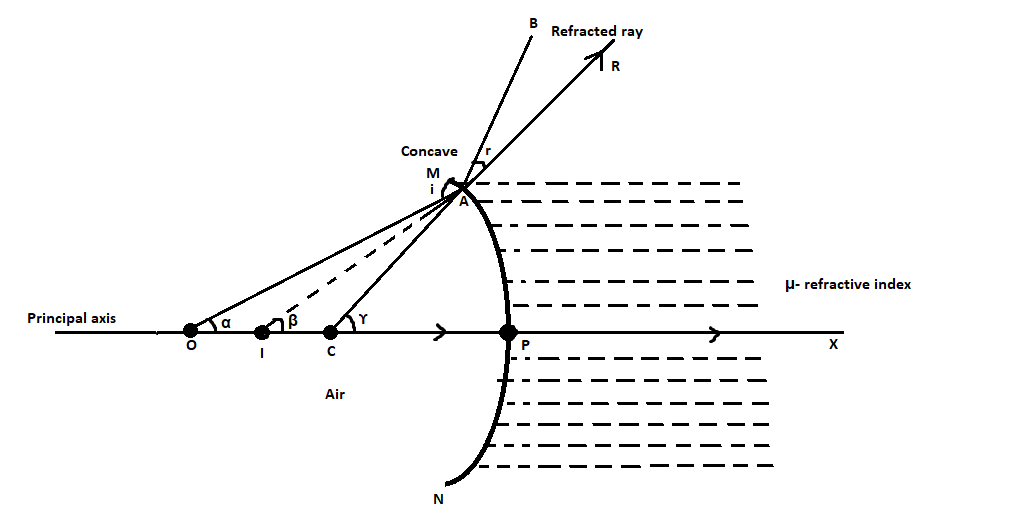
Derive the following expression for the refraction at concave spherical surface:
Answer
430.7k+ views
3 likes
Hint
A spherical mirror is a part of a sphere with a reflecting surface. If the inner surface is the reflective surface then the mirror is called a concave mirror and if the outer surface is the reflecting surface then the mirror is called a convex mirror. Here we have a concave reflecting surface for which we have to derive the given expression.
Complete step by step answer
Let us consider a concave mirror as shown in the diagram below,

The concave mirror is represented by
Let us consider the ray angles with the principal axis to be
According to Snell’s law, we can write the refractive index as
Where
Here we have very small
We get,
From this we get,
By using the exterior angle theorem, from
From this we get
Now, by using exterior angle theorem in
From this we get,
Substituting these values of
For a spherical surface, we can write the angle as
We can write
And
Also
Substituting these values of
Taking the common terms outside we get,
Now we have to apply the sign convention.
Putting these values in equation
We get,
Opening the brackets on LHS
Opening the brackets on RHS
Rearranging, we get
We can write this expression as,
Hence we got the required expression for the concave refractive surface.
Note
According to the Cartesian sign convention,
-All distances as measured from the pole of the mirror.
-The distances that are measured in the direction of the incident light are taken as positive.
-The distances that are measured opposite to the direction of incident light is considered as negative.
-The height measured upward the principal axis is measured as positive and the height measured downward is measured negative.
A spherical mirror is a part of a sphere with a reflecting surface. If the inner surface is the reflective surface then the mirror is called a concave mirror and if the outer surface is the reflecting surface then the mirror is called a convex mirror. Here we have a concave reflecting surface for which we have to derive the given expression.
Complete step by step answer
Let us consider a concave mirror as shown in the diagram below,

The concave mirror is represented by
Let us consider the ray angles with the principal axis to be
According to Snell’s law, we can write the refractive index as
Where
Here we have very small
We get,
From this we get,
By using the exterior angle theorem, from
From this we get
Now, by using exterior angle theorem in
From this we get,
Substituting these values of
For a spherical surface, we can write the angle as
We can write
And
Also
Substituting these values of
Taking the common terms outside we get,
Now we have to apply the sign convention.
Putting these values in equation
We get,
Opening the brackets on LHS
Opening the brackets on RHS
Rearranging, we get
We can write this expression as,
Hence we got the required expression for the concave refractive surface.
Note
According to the Cartesian sign convention,
-All distances as measured from the pole of the mirror.
-The distances that are measured in the direction of the incident light are taken as positive.
-The distances that are measured opposite to the direction of incident light is considered as negative.
-The height measured upward the principal axis is measured as positive and the height measured downward is measured negative.
Recently Updated Pages
Master Class 9 General Knowledge: Engaging Questions & Answers for Success

Master Class 9 English: Engaging Questions & Answers for Success

Master Class 9 Science: Engaging Questions & Answers for Success

Master Class 9 Social Science: Engaging Questions & Answers for Success

Master Class 9 Maths: Engaging Questions & Answers for Success

Class 9 Question and Answer - Your Ultimate Solutions Guide

Trending doubts
Give 10 examples of unisexual and bisexual flowers

Draw a labelled sketch of the human eye class 12 physics CBSE

Differentiate between homogeneous and heterogeneous class 12 chemistry CBSE

Differentiate between insitu conservation and exsitu class 12 biology CBSE

What are the major means of transport Explain each class 12 social science CBSE

Why is the cell called the structural and functional class 12 biology CBSE




